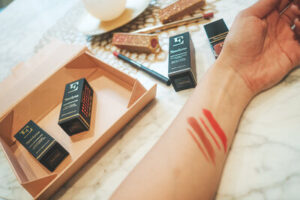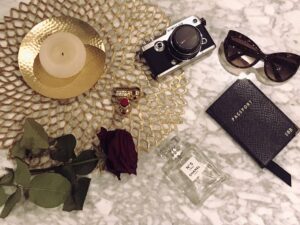Article Cover Photo: © Africa Images via canva.com
Is there anything more luxurious than resting your head on a soft, silky smooth pillowcase? We’ll admit, when looking to trade in a traditional cotton pillowcase for a set of silky pillows, chances are the silk vs satin pillowcase dilemma is going to crop up, and we’ll bet that your first thought might be: is there even a difference between silk and satin?
The short answer is yes – and we’ve got all the answers you might be looking for when it comes to silk vs satin pillowcases and which one you should consider purchasing based, of course, on which material works best for you!
This article contains affiliate link
Silk vs Satin Pillowcases: Is There a Difference?
Whether investing in a silky dressing gown or searching for new luxury bedding and that all important pillowcase, you’re likely to come across both silk and satin options. These two fabrics may look quite similar yet, in reality, they are two very different types of material. Despite sharing a similarly glossy appearance and luscious smoothness, silk and satin harbour a fundamental difference which shoppers should be aware of before investing in a new pillowcase.
The difference between the two ultimately boils down to their natural composition. Silk is a type of fabric produced by silkworms, yielding an entirely natural product which is 100% a natural protein. On the other hand, satin is not a fabric in itself but instead refers to a unique style of weaving that can be applied to a variety of fabrics, ranging from natural to synthetic. Whilst it is possible to find satin woven from real silk, it is much more common to find satin made up of industrial-made synthetic material, making this a vastly cheaper option to the harder to obtain true silk.
A second key difference is that silk has the same look and feel on either side of the fabric, whilst satin has a smooth, glossy appearance on the front and a rougher appearance on the back.
Nevertheless, both silk and satin pillowcases have their own unique benefits and advantages over one another, granting them both a valued place in the bedding market. Let’s take a look at what they both have to offer!
Silk Pillowcase Benefits
- Silk is Free from Synthetic Fibres: made of natural protein fiber, silk fabric pillowcases are entirely free from synthetically manufactured fibres. Generally, the skin is more likely to become irritated when it comes in contact with synthetic material such as polyester, rayon and nylon, as these have a less breathable quality than naturally obtained fibres. Ultimately, pure silk is kinder to the skin and less likely to lead to fabric allergies.
- It Causes Less Friction With Skin and Hair: it is natural to toss and turn in your sleep, especially on those hot summer nights. This can sometimes result in your hair becoming a little bit of a tangled mess, and not to mention, your face enduring unnecessary rubbing against the pillow – that certainly doesn’t help with unwanted premature lines and wrinkles! Undeniably, tossing and turning is not something that can easily be controlled, but opting for a silk pillowcase is within your power and this can considerably lessen the adverse effects of sleep movement. Silk being such a smooth – and almost watery – surface, does not tug at your facial skin during the night like average cotton pillowcases might, and it also lessens the friction created on your hair.
- Silk Doesn’t Absorb Essential Moisture: We all know that when the skin is not well-hydrated it becomes uncomfortably dry, tight and perhaps even flaky. Similarly, dry hair can lead to frizz, which effectively destroys a super straight blow-dry or freshly Dyson Airwrapped big bouncy curls. Unlike other porous materials like cotton, silk does not absorb any moisture, making it possible to rest your face and hair on a silk pillowcase without worrying it will rob you of any essential moisture during the night.
- Silk is More Hygienic: The fact that silk does not absorb oils, product and sweat from your face means it won’t become a breeding ground for germs like other absorbent materials. This makes it a cleaner and safer surface to lay your head upon, especially for anyone prone to acne breakouts.
- It Regulates your Body Temperature: Silk offers wonderful temperature regulating qualities and is a natural thermal regulator. This means that when using a silk pillowcase, there is no need to keep flipping the pillow in search of a cool spot to rest your head. How? It’s actually pretty clever. Being a natural fibre, it’s great at retaining a warm layer of air next to the skin, but thanks to it’s breathability, it won’t leave your feeling hot and sweaty.
- It’s Naturally Hypoallergenic: In being a more hygienic and breathable material, silk prevents allergens – such as dust mites, mould and fungus – from developing and building up. This gives silk pillowcases a beneficial hypoallergenic quality that synthetic fabrics just do not have.
- It is More Durable than Cotton: Despite its delicate and fragile appearance, silk is actually a very durable material that even rivals cotton. With proper care, a pair of silk pillowcases can last a long time, making this a sustainable purchase as well as an excellent long-term investment.
- Silk Looks and Feels Incredibly Luxurious: Nothing beats the luxurious aesthetic and milky texture of silk bedding. No one can deny that resting your head on silk pillows both looks and feels decadently lavish, even before knowing the full benefits this natural fabric offers.

Satin Pillowcase Benefits
Despite their fundamental differences, silk and satin pillowcases share some aesthetic similarities. As satin pillowcases look quite similar to real silk pillow-covers, their glossy aesthetic also help to give off a luxuriously polished look. In addition, just like silk, satin pillowcases have a smooth and slippery surface that is just as effective for those wishing to avoid a rough surface rubbing against their hair and face, and celebs such as Cindy Crawford and Victoria Beckham are known fans.
Whilst they may not share the more ‘natural’ benefits such as being naturally hypoallergenic, satin pillowcases also enjoy a few benefits that are unique to them.
- Satin is Easier to Find: As satin is not the rare commodity that silk is, it is easier to come across satin pillowcases when shopping for new bedding. In order to get a genuine silk pillowcase made from 100% Mulberry silk, it is better to shop from companies that specialise in silk products, such as Lilysilk. On the other hand, many more stores will have satin products at hand, making them much easier to find.
- Satin is More Affordable: Unlike silk – which is harvested from hundreds of silkworms – satin is weaved out of different natural and synthetic fabric. Naturally, this makes satin pillowcases easier to produce, resulting in a budget friendly price tag that comes at half the price of a genuine silk pillowcase.
- Unlike Silk, Satin is Machine Washable: Whilst silk is a delicate material that needs to be hand-washed, satin can conveniently be popped into the washing-machine without being ruined. This is definitely a plus for busy individuals!
- Satin Can be Softer and More Forgiving than Silk: As satin pillowcases use a combination of fabrics – at times blending silk with synthetic material – they can sometimes feel softer to the touch. The blend of natural and synthetic fibres also lends strength to the material, making satin pillowcases more durable than those made of pure silk.

Silk vs Satin Pillowcases: Which are Best for You?
Having detailed their individual strengths, the question remains: which is better for you – a silk or satin pillowcase? In truth, this all depends on what you’re looking to get out of your new pillowcase. We know that satin is the more budget-friendly option and easier to clean and maintain, yet we know that silk is the entirely natural option of the two, whilst being hypoallergenic and more hygienic.
If you’re still undecided as to which is best for you, it all boils down to what you are more concerned about. Are you mostly concerned with keeping your hair frizz-free? Is caring for your face your main priority? To leave no stone unturned, here’s some additional info on what works best for maintaining beautiful looking hair and healthy skin when it comes to pillowcases.
Silk vs Satin Pillowcase For Hair: Both Work!
Anyone with particularly dry or curly hair will know how difficult it is to style very frizzy hair. Many will be able to relate to going to bed with beautifully styled hair, only to wake up with hair in a frizzy mess. Nevertheless, there are a number of frizz-taming tricks one can try, and sleeping on a silk or satin pillowcase is certainly one of them. As silk and satin pillowcases share a slippery and delightfully smooth surface, both make great choices for reducing hair damage and keeping unwanted frizz at bay.
Silk vs Satin Pillowcase For Skin: We Recommend Silk!
When it comes to your facial skin, the more natural the material the better! Although a satin pillowcase is not likely to tug at the your face during the night, when made from synthetic material, it does not offer silk’s natural breathability. For some, satin’s lack of breathability means that their beauty sleep is affected by uncomfortable trapped heat which, on hot days, can easily keep a light sleeper awake.
And as we know, silk is a non-absorbent material, making it less likely to smear pollutants – and any hair oils or products – upon your face. Admittedly, satin is not as absorbent as cotton, but its moisture wicking properties all depends on the type of material used to weave it. In short, silk is always a safer option when considering facial skincare.
Don’t forget to pin this article if you found it helpful, and follow Dukes Avenue on Pinterest for more!
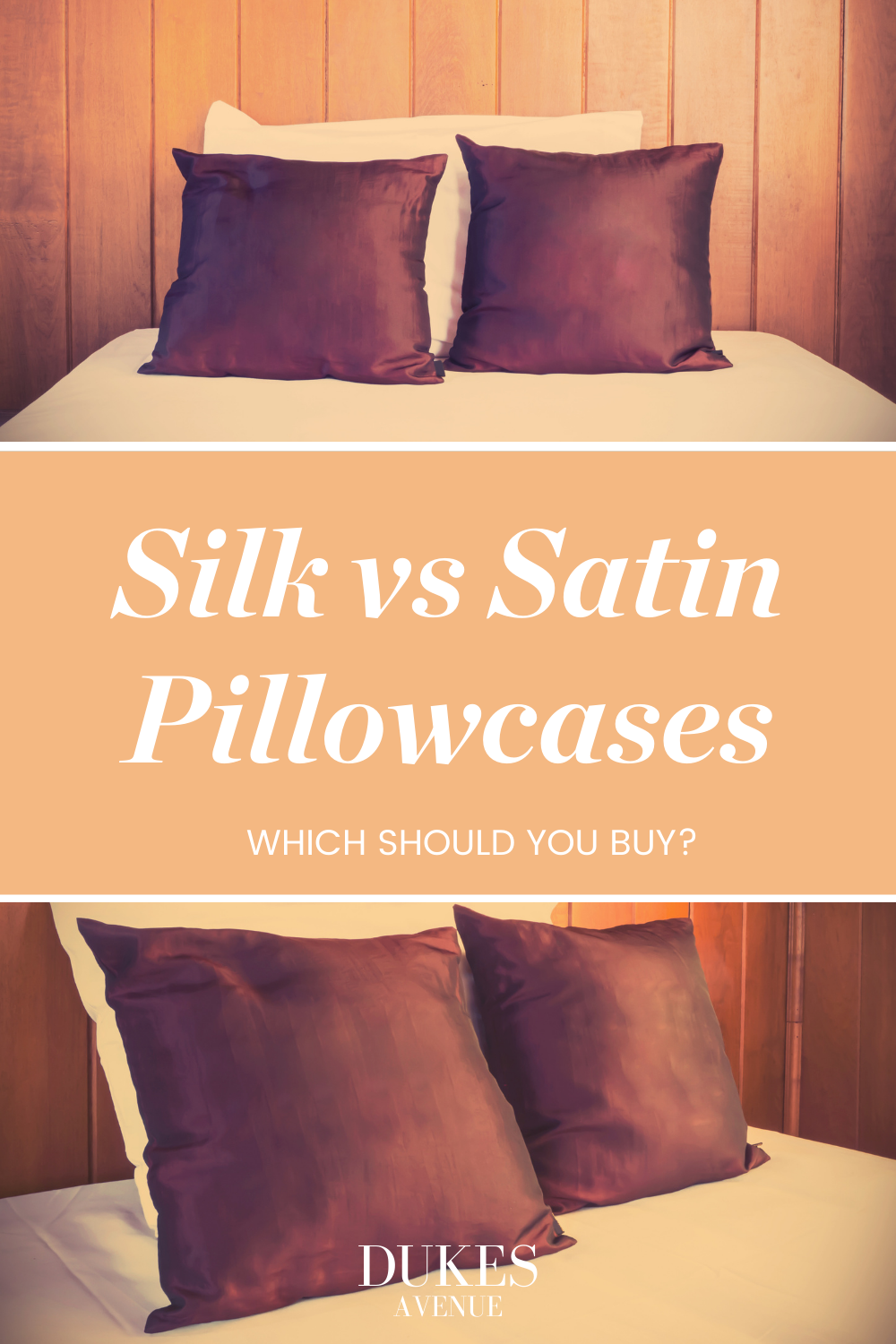
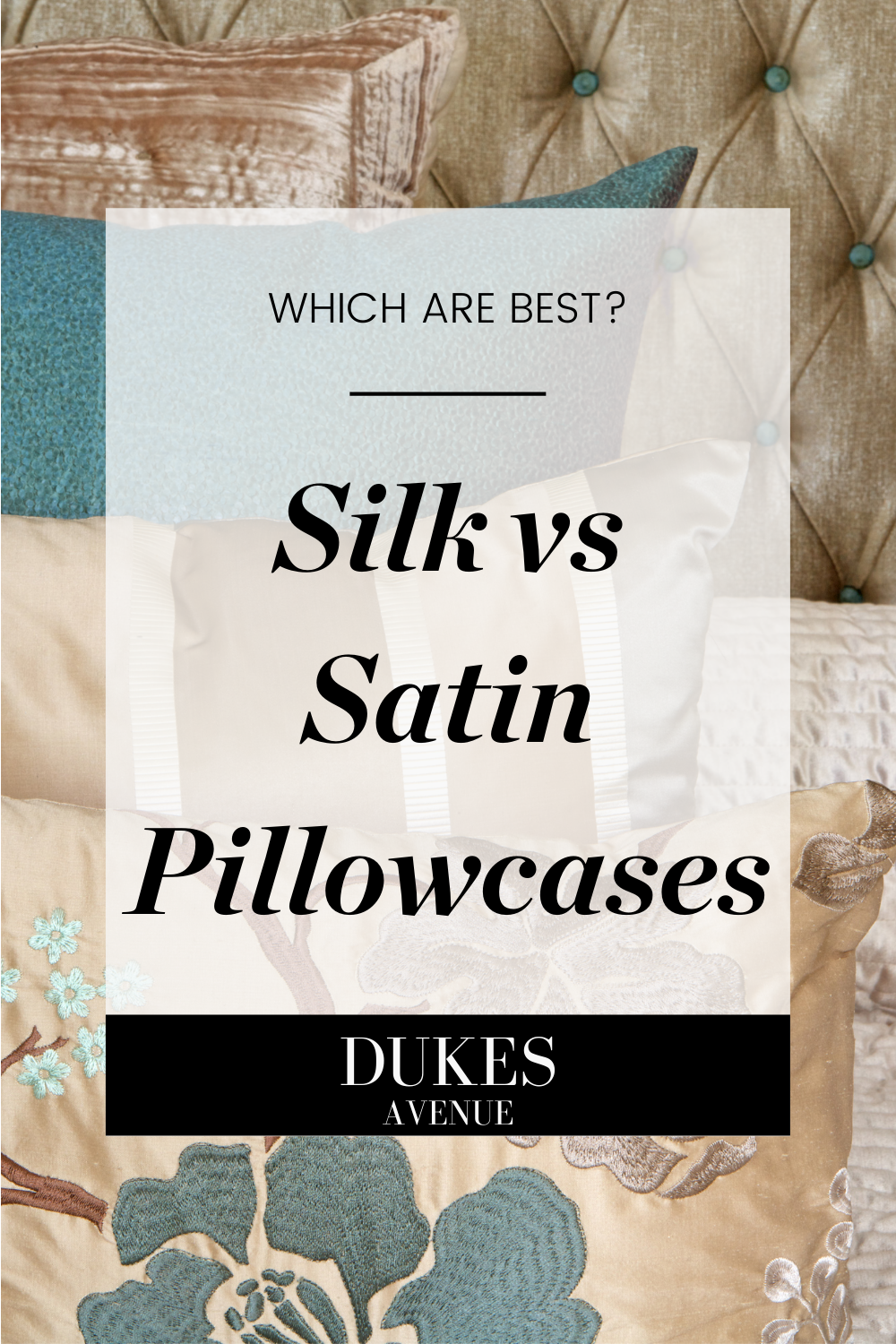
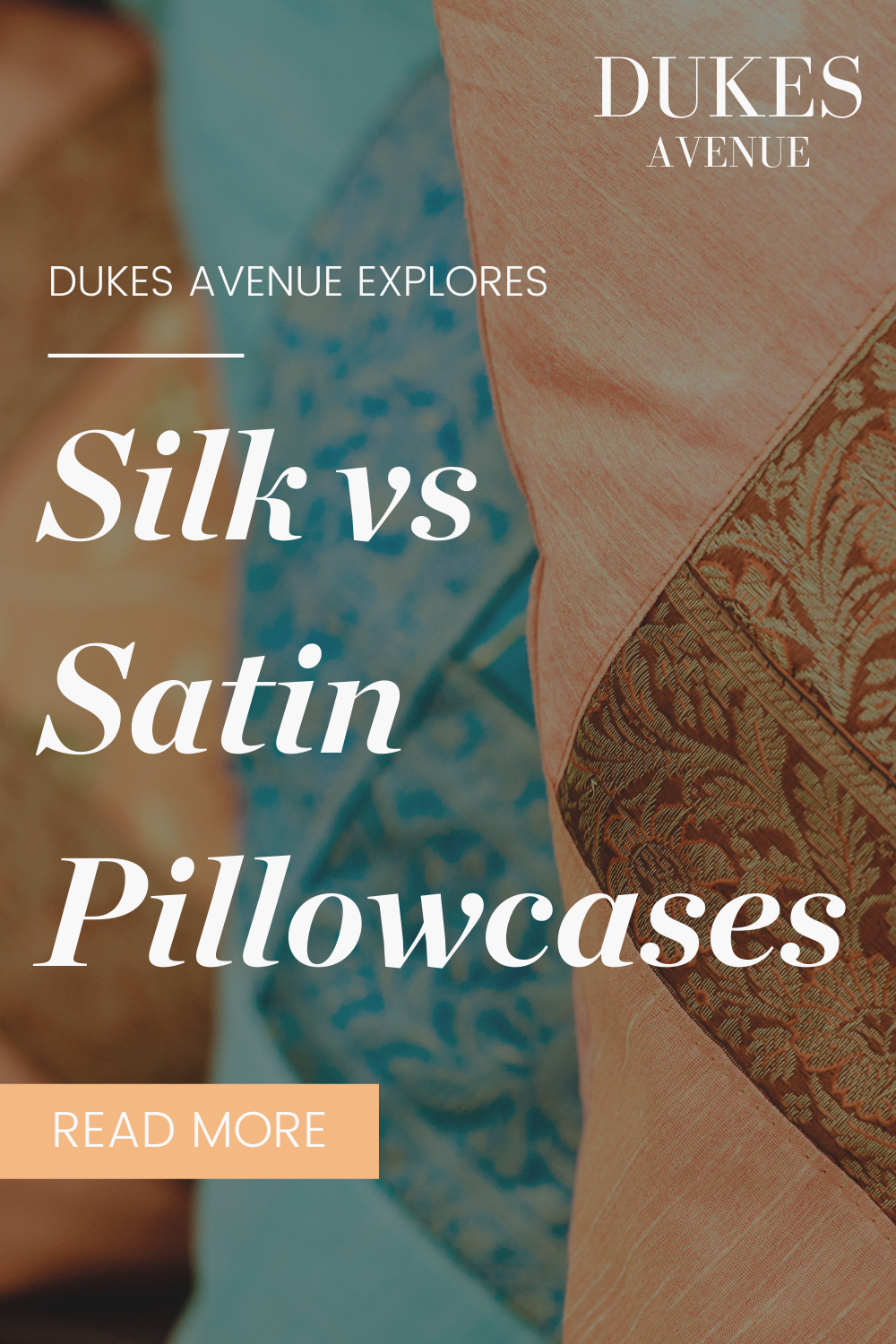

Christine is a woman with an eclectic range of artistic tastes. As a professional soprano with a Bachelor's Degree in Music, she carries over 15 years of experience in the classical music scene, both locally and abroad. Her passion for music is equalled by her love for literature and, more recently, Christine graduated for a second time with a BA in English.
-
Christine Barbarahttps://dukesavenue.com/author/christine-barbara/
-
Christine Barbarahttps://dukesavenue.com/author/christine-barbara/
-
Christine Barbarahttps://dukesavenue.com/author/christine-barbara/
-
Christine Barbarahttps://dukesavenue.com/author/christine-barbara/


